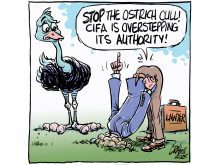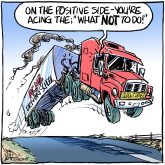The tragic events in the United States don’t necessarily mean market panic.
It is difficult to comprehend the events of Sept. 11.
Coincidentally, I was visiting the World Trade Centre and our offices in New York while on holiday the previous week, so I personally feel quite fortunate.
Tuesday’s developments are an unprecedented attack on the U.S. and its economic infrastructure.
Typically the investor reacts to uncertainty in chaotic times with an instinctive response to panic sell. Although the recent events are extremely serious, it is important to bring historical context and anticipated market reaction into perspective so that prudent decisions can be made within an individual’s portfolio.
Read Also

Rural communities can be a fishbowl for politicians, reporter
Western Producer reporter draws comparisons between urban and rural journalism and governance
Political and economic events often create severe volatility in the markets, leading to significant declines lasting days to months. For example, if we go back 10 years, the investor has faced the following crises.
- 1990-1991: Iraq’s invasion of Kuwait and the Gulf War. At this time the U.S. was in economic recession, with news of job cuts and layoffs dominating headlines. Business investment had dried up and the country was suffering from the collapse of real estate prices and the massive savings and loan crisis.
- 1994: The financial crisis in many emerging markets. Mexico’s currency devalued by 50 percent overnight. Also, global interest rates were being increased to deal with rising inflation.
- 1997: The Asian financial crisis with the collapse of currencies in Asia.
- 1998: The implosion of the Russian ruble and losses by Long-term Capital Management, bringing markets to the edge of disaster.
It’s important to note that in each of the cases the markets dropped, with the amount varying from 15 to 30 percent. In each case, however, they recovered to higher levels 12 months later.
We should also anticipate market reaction to these events and understand how it could be supportive to the markets into 2002.
Anticipated reactions include:
- When in crisis, the central banks provide quite a bit of liquidity and ease to reduce the risk of the economic system seizing.
The U.S. Federal Reserve had already adopted a policy of easing interest rates and it will now most likely accelerate this. Indeed, it dropped rates by 50 basis points Sept. 17.
We believe fears on Wall Street prior to the tragedy that the Fed would shift to a neutral position are now gone. In fact, with core inflation at around two percent versus the Fed Funds rate at 3.5 percent, the Fed has substantial room for further rate ease when compared to its low of three percent in September 1992 when core inflation was 4.1 percent.
Other central banks, like the European Central Bank, the Bank of England and the Bank of Canada, are likely to ease rates well into mid-2002. We foresee central banks maximizing their efforts to improve the business cycle.
n Focus on security in its broadest sense is likely to increase. In our view, a global focus on enhanced security is also likely to be long lasting and certainly through mid-2002. Security enhancement will likely include defence spending, increased emphasis on technology security such as encryption and other forms of computer and software security, and personal security. Stocks involved in these types of businesses should benefit.
- Demand from business and the consumer for information and interest in the news media is likely to rise, similar to that seen during the Gulf War. This should be supportive to media stocks.
- The desire for risk aversion is naturally likely to increase. The federal reserve and the other central banks are already likely focused on preventing more cooling in the economy, although certain business sectors can’t help but be affected in the short term. For example, as travel in North America is expected to be reduced, airline and hotel stocks may come under pressure.
In the currency markets, the U.S. dollar remains the dominant reserve currency. The Fed was well ahead in its policy of easing rates even before the tragedy. The U.S. dollar is likely to remain stable for these reasons.
Gold should trade within a range of $260-$300 US per ounce, closer to the upper end of the range. This should be supportive to gold stocks.
Markets have a tendency to overreact to bad news. For example, there were signs of reactive panic in the sharp price drops in Japanese and German equities just after the attacks.
However, after a 10 percent drop, these markets appear to have stabilized. As such, for those who have cash and the courage to invest, this may be an opportunity once North American markets react. It is important to remember that we have seen bad news in the past but it has never provided a lasting negative impact on the markets. The valuation of many businesses will be the same tomorrow as they were yesterday.
Our thoughts and prayers go out to those affected by this tragedy.
Ian Morrison is a financial consultant with Wood Gundy Private Client Investments in Calgary and is licensed to sell insurance products. His views do not necessarily reflect those of CIBC World Markets Inc. This article is for information only. Morrison can be reached at 800-332-1407 or by e-mail at ian.morrison@cibc.ca.














